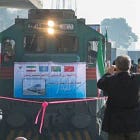Tightening the Belt: GCC-ASEAN-China Towards BRICS
A more China-aligned GCC is a strategic step to hedge against Iran's Looking East Strategy.
On 27 May, the Association of Southeast Asian Nations (ASEAN) held its first trilateral summit with the Gulf Cooperation Council (GCC) and China in Kuala Lumpur. Following US President Trump's recent visit to the Gulf, the summit may be interpreted as a signal of balance in response to the instability and unpredictability emanating from Washington. By strengthening ties through trade, infrastructure, and cultural initiatives, these blocs aim to bolster regional resilience and advance the China-led BRICS framework.
Slowly but Surely: Towards GCC–ASEAN–China Potential
Since their inaugural ministerial meeting in 2009, GCC-ASEAN ties have been constrained by divergent priorities and the 2017–2021 Qatar diplomatic crisis. However, ties have strengthened in recent years, culminating in the landmark 2023 GCC-ASEAN Summit in Riyadh, where both blocs adopted a robust cooperation framework to enhance collaboration in critical sectors: trade, energy, and technology.
While a Free Trade Agreement (FTA) between the GCC and ASEAN remains under negotiation, the recent trilateral summit involving China reaffirmed their commitment to closer ties with China and Asia. The summit highlighted the potential of a combined market of over 2 billion people and a collective GDP nearing $25 trillion. Leaders also pledged to expedite negotiations for a GCC–China FTA, now in its eleventh round since 2004, and to strengthen the existing ASEAN–China Free Trade Area. With the Syrian conflict (a previous sticking point) no longer an issue following Assad’s ousting, the GCC–China FTA appears closer to finalisation.
In a further move to bolster ties, China introduced a one-year visa-free policy for citizens of four Gulf countries effective from 9 June: Saudi Arabia, Oman, Kuwait, and Bahrain. This policy grants all GCC citizens visa-free access to the People’s Republic, underscoring China’s commitment to deepening economic and diplomatic engagement with the region.
Step Ahead of Iran?
The GCC-ASEAN-China trilateral summit reflects not only economic ambitions but also a strategic manoeuvre by the GCC to hedge against Iran’s growing influence in Asia. Iran has steadily deepened its economic and diplomatic ties with Asian powers, particularly through its integration into China’s Belt and Road Initiative (BRI). This has positioned Iran as a key player in regional connectivity and trade networks, prompting the GCC to strengthen its own Asian partnerships to counterbalance Tehran’s expanding reach. That said, despite Iran’s robust ties with China, which includes a comprehensive strategic partnership, Iranian citizens still require visas for entry into the People’s Republic, even for short-term tourism.
Nevertheless, a more China-aligned GCC could pave the way for improved relations with Iran, given Beijing’s growing influence over both parties. China’s diplomatic efforts, notably its mediation of the landmark 2023 Iran-Saudi rapprochement, demonstrate its capacity to foster dialogue between rivals. As China advances its terrestrial BRI projects, which increasingly integrate Iran into regional trade corridors, it may encourage a thaw in GCC-Iran tensions. Such developments could facilitate broader regional cooperation, aligning with China’s vision of a multipolar economic order.
Building Blocs for BRICS
This deepening of trilateral ties comes amid President Trump’s tariff war and reflects a broader effort to stabilise and strengthen regional relations independent of Washington. Several ASEAN nations, notably Cambodia, Laos, and Vietnam, have faced severe US import duties approaching 50%, underscoring the urgency of diversifying economic partnerships. Against this backdrop, ASEAN, the GCC, and China have all reaffirmed their commitment to advancing China’s BRI, considered a vital artery of the BRICS framework.
China has pledged significant investments in transformative infrastructure projects across ASEAN and GCC countries, including the development of a major port and industrial hub on Malaysia’s northeast coast. These initiatives aim to enhance regional connectivity and economic integration, aligning with the broader objectives of the BRICS coalition. Furthermore, discussions have intensified regarding the GCC’s potential engagement with the Regional Comprehensive Economic Partnership (RCEP), the 15-member trade pact encompassing China, ASEAN, and other Asia-Pacific nations. ASEAN has responded by committing to feasibility studies to explore the GCC’s integration into this framework, a move that could amplify the combined market potential of over 2 billion people and a collective GDP nearing $25 trillion, as highlighted at the recent trilateral summit.
Beyond economic cooperation, ASEAN, the GCC, and China issued a joint statement addressing the humanitarian crisis in Gaza, expressing profound concern and calling for an immediate ceasefire and the protection of civilian lives. This unified stance underscores their growing alignment on global issues and signals a shared commitment to the priorities of the Global South, challenging Western hegemony. This position builds on longstanding interregional ties rooted in historical trade networks and shared religious and cultural heritage. To further strengthen these connections, Malaysia proposed a Confucian-Islamic civilisational dialogue, which garnered China’s support. This initiative aims to foster cultural exchange and deepen mutual understanding, reinforcing the ideological and strategic alignment among these blocs within the BRICS framework.




